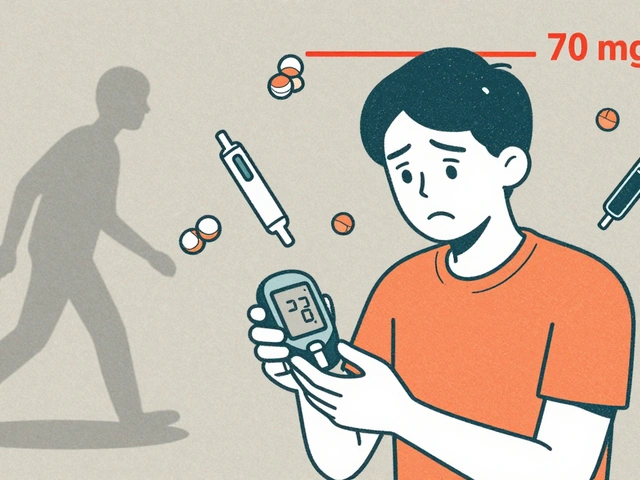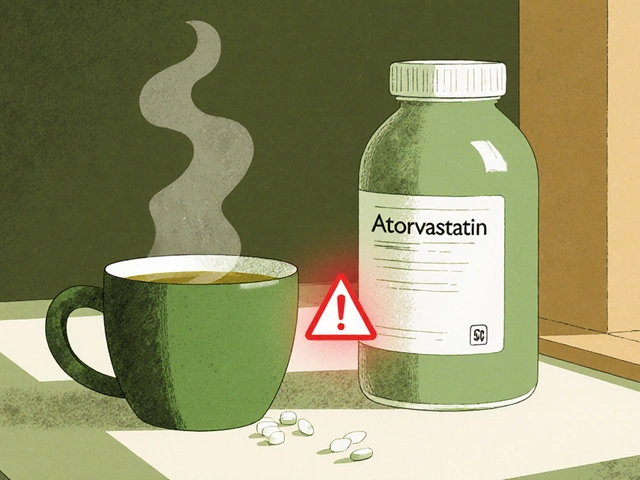Diabetes Medication Decision Guide
Find Your Best Diabetes Medication
Answer a few questions about your health priorities to see which medications best match your needs.
What matters most to you?
Choosing the right medication for type 2 diabetes can feel like hunting for a needle in a haystack. With dozens of options, patients and clinicians alike need a clear side‑by‑side view of how each drug stacks up. This guide breaks down dapagliflozin - marketed as Dapasmart - against the most common alternatives, so you can see which one fits your health goals, budget, and lifestyle.
Key Takeaways
- Dapasmart (dapagliflozin) is an SGLT2 inhibitor that lowers HbA1c by 0.5%‑0.9% and cuts heart‑failure risk.
- Empagliflozin (Jardiance) has the strongest cardiovascular‑mortality data, while canagliflozin (Invokana) shows the best renal‑protective effect.
- GLP‑1 agonists like Ozempic provide superior weight loss but require injections.
- Metformin remains the cheapest first‑line option, though it lacks the heart‑failure benefits of SGLT2 drugs.
- Cost, side‑effect profile, and kidney function are the top three decision factors for most patients.
Dapasmart is a branded formulation of dapagliflozin, an oral selective sodium‑glucose co‑transporter‑2 (SGLT2) inhibitor. Approved by the FDA in 2014 for adults with type 2 diabetes, Dapasmart is taken once daily with or without food. Typical dosing starts at 5mg and can be increased to 10mg if glycemic control needs a boost. The drug works by preventing glucose reabsorption in the kidney, so excess sugar exits the body through urine.
How We Compare Diabetes Medications
To keep the analysis fair, we evaluate each drug on six objective pillars:
- Glycemic efficacy - average drop in HbA1c after 24weeks.
- Cardiovascular outcomes - impact on heart‑failure hospitalization and major adverse cardiac events (MACE).
- Renal protection - slowing of eGFR decline or reduction in albuminuria.
- Side‑effect profile - common adverse events and serious warnings.
- Cost & insurance - average wholesale price (AWP) and typical out‑of‑pocket expense in the U.S.
- Dosing convenience - pill vs injection, frequency, and need for titration.
Side‑by‑Side Comparison Table
| Drug (Brand) | Generic | Class | HbA1c reduction | Cardio benefit | Renal effect | Typical AWP (US$) | Common side‑effects |
|---|---|---|---|---|---|---|---|
| Dapasmart | dapagliflozin | SGLT2 inhibitor | 0.6‑0.9% | ↓ HF hospitalisation (≈27% risk reduction) | Modest eGFR slowing | $315 / month | UTI, genital mycotic infection, volume depletion |
| Jardiance | empagliflozin | SGLT2 inhibitor | 0.5‑0.7% | ↓ MACE (14% reduction) & CV mortality (38%) | Good eGFR preservation | $340 / month | Similar to Dapasmart, plus rare ketoacidosis |
| Invokana | canagliflozin | SGLT2 inhibitor | 0.7‑1.0% | ↓ HF hospitalisation (≈30%) | Strong renal‑protective data (CREDENCE trial) | $325 / month | Higher amputation warning, bone fracture risk |
| Farxiga | dapagliflozin (generic) | SGLT2 inhibitor | 0.6‑0.9% | Similar to Dapasmart | Modest renal benefit | $260 / month | Same class‑related risks |
| Ozempic | semaglutide | GLP‑1 receptor agonist | 1.0‑1.5% | ↓ MACE (26% reduction) | Improves eGFR modestly | $950 / month (injection) | Nausea, vomiting, pancreatitis (rare) |
| Metformin | metformin hydrochloride | Biguanide | 0.8‑1.2% | No proven CV mortality benefit | Neutral renal effect | $4 / month (generic) | GI upset, lactic acidosis (rare) |
Deep Dive into the Alternatives
Jardiance (empagliflozin) stands out for its hard‑won cardiovascular‑mortality data from the EMPA‑REG OUTCOME trial. If you have established heart disease, Jardiance often edges out other SGLT2 inhibitors. Its once‑daily dosing mirrors Dapasmart, and the side‑effect profile is nearly identical.
Invokana (canagliflozin) gained fame after the CREDENCE trial proved a 30% reduction in kidney disease progression. However, clinicians stay cautious because a 2017 FDA warning highlighted an increased risk of lower‑leg amputations, especially in patients with peripheral artery disease.
Farxiga (generic dapagliflozin) delivers the same efficacy as Dapasmart at a lower price point, making it attractive for cash‑pay patients or those with high deductible plans. The only trade‑off is brand‑name support services, which some patients miss.
Ozempic (semaglutide) isn’t an SGLT2 inhibitor; it’s a GLP‑1 agonist that mimics the gut hormone GLP‑1, boosting insulin secretion and slowing gastric emptying. The result is pronounced weight loss (up to 15lb) and robust HbA1c drops, but you must inject it weekly. Insurance coverage varies, and the cost can be prohibitive without benefits.
Metformin remains the cheapest, widely prescribed first‑line therapy. It works by decreasing hepatic glucose production and improving insulin sensitivity. Though it lacks the heart‑failure benefits of SGLT2 drugs, it’s often combined with them for additive effect.
Which Drug Is Best For You?
- Heart‑failure patients: Dapasmart or Invokana - both cut HF hospitalisations. Jardiance may be preferable if you also need mortality reduction.
- Kidney‑disease concerns: Invokana has the strongest data, followed by Jardiance and Dapasmart.
- Weight‑loss focus: Ozempic outperforms all oral agents, but consider injection willingness and cost.
- Budget‑tight scenario: Metformin + generic dapagliflozin (Farxiga) offers solid control without breaking the bank.
- Risk of genital infections: All SGLT2 inhibitors share this risk. Good hygiene and staying hydrated can mitigate it.

Practical Tips for Starting an SGLT2 Inhibitor
- Check kidney function (eGFR ≥45mL/min/1.73m² for Dapasmart).
- Discontinue if you’re on a loop diuretic and have low blood pressure - volume depletion can be a problem.
- Educate yourself on signs of ketoacidosis (nausea, abdominal pain, rapid breathing) even if blood sugar looks okay.
- Schedule a follow‑up labs check at 4‑6 weeks to gauge kidney and electrolytes.
- If you develop a urinary‑tract infection, pause the medication until it resolves.
Frequently Asked Questions
Can I take Dapasmart with Metformin?
Yes. Combining an SGLT2 inhibitor like Dapasmart with Metformin is a common strategy. Metformin handles hepatic glucose output while Dapasmart adds urinary glucose loss, often yielding a greater overall HbA1c drop.
What should I do if I get a yeast infection?
Treat the infection promptly with over‑the‑counter antifungal cream and keep the area dry. If infections recur, talk to your doctor about switching to a different class.
Is Dapasmart safe for people with mild kidney disease?
For an eGFR of 45‑60mL/min/1.73m², Dapasmart is still approved, but the dose may be limited to 5mg. Below 45mL/min, clinicians usually switch to another agent.
How does the cost of Dapasmart compare to generic dapagliflozin?
Brand‑name Dapasmart typically costs about $315 per month in the U.S., while the generic version (often sold as Farxiga) runs roughly $260. Insurance formularies sometimes favor the generic, but check your plan’s tier.
Can I take Dapasmart if I’m pregnant?
SGLT2 inhibitors are not recommended during pregnancy. They cross the placenta and may affect fetal kidney development. Switch to insulin or metformin under medical supervision.
Next Steps
Grab your latest lab results and jot down any heart‑ or kidney‑related diagnoses you have. Bring that list to your next appointment and ask your clinician which of the options above aligns with your health profile and budget. Remember, the best drug is the one you’ll actually take consistently.
By weighing efficacy, safety, cost, and convenience, you can make an informed choice between Dapasmart and its alternatives. Stay proactive, keep communication open with your care team, and monitor your numbers regularly - that’s the real secret to long‑term success.








13 comments
SHASHIKANT YADAV
When you look at the HbA1c drop numbers, the SGLT2 class shows a tight range that makes choosing based on glucose control alone a bit of a guessing game 😊. Dapasmart sits squarely in the middle with a 0.6‑0.9% reduction, which is comparable to Farxiga and a notch better than Jardiance on the low end. The cardiovascular benefit, roughly a 27% reduction in heart‑failure hospitalization, lines up nicely with the class effect but doesn’t reach the mortality edge that Empagliflozin grabs. From a cost perspective, $315 a month is a sweet spot between the pricier GLP‑1 agents and the bargain bin Metformin. All things considered, the drug feels like a solid middle‑ground option for patients who need both glucose and heart‑failure protection without breaking the bank.
Ryan Pitt
Keep it simple-pick the drug that fits your wallet and lifestyle.
Jami Johnson
In the grand tapestry of diabetes management, each medication is a thread weaving together efficacy, safety, and personal circumstance. Dapasmart, as a member of the SGLT2 family, pulls a subtle hue of renal protection while simultaneously shading the canvas with modest HbA1c decline. The heart‑failure benefit, a 27% dip in hospitalizations, is the quiet brushstroke that can save lives without the fanfare of mortality reduction seen in its cousin, Empagliflozin. Yet the story does not end there; the risk of genital infections looms like a faint watermark, reminding clinicians to counsel patients on hygiene and hydration. Cost, meanwhile, writes its own subplot-at $315 per month Dapasmart is neither the pauper’s choice nor the aristocrat’s indulgence, positioning it in the pragmatic middle ground.
When juxtaposed with Ozempic, the GLP‑1 hero, the contrast is stark: Ozempic delivers dramatic weight loss and a 1.0‑1.5% HbA1c plunge, but it demands weekly injections and a staggering $950 price tag. For patients averse to needles or constrained by insurance formularies, Dapasmart offers oral convenience that cannot be understated. The renal narrative further deepens; while Invokana boasts the strongest kidney data from the CREDENCE trial, its amputation warning casts a shadow that may deter those with peripheral vascular disease. Dapasmart’s modest eGFR slowing, though less spectacular, carries fewer red‑flag alerts, making it a safer bet for many.
From a mechanistic lens, the inhibition of sodium‑glucose cotransporter‑2 reduces glucose reabsorption by roughly 30‑40%, a physiologic shift that translates into modest weight loss and diuretic‑like effects. This diuresis can be a double‑edged sword: beneficial for volume‑overloaded heart‑failure patients, yet a potential culprit for hypotension in the frail elderly. Hence, baseline blood pressure and concomitant diuretic therapy must be evaluated before prescribing. Moreover, the rare but serious risk of euglycemic ketoacidosis demands vigilance, especially when patients reduce carbohydrate intake or undergo surgical stress.
In sum, Dapasmart occupies a nuanced niche: not the most potent glucose reducer, not the most dramatic heart‑killer, but a balanced, oral, cost‑effective option for a broad swath of type‑2 diabetics. The art of prescribing lies in matching this profile to the individual’s comorbidities, financial realities, and personal preferences. When done thoughtfully, Dapasmart can be a quiet workhorse that quietly slides patients toward their glycemic and cardio‑renal goals without the drama of injections or the dread of prohibitive costs.
Kasey Krug
The table presents the data accurately, but the narrative adds little beyond what is already known. All SGLT2 inhibitors share similar HbA1c reductions and a class‑wide heart‑failure benefit. The cost differentials, while noteworthy, are not dramatic enough to overhaul prescribing habits. A deeper dive into patient‑reported outcomes would have been more valuable than reiterating the same percentages. Overall, the piece feels redundant.
jake cole
This comparison is a waste of time because the market already knows which drug wins. Everyone with a pulse can see that the cheaper generic beats the brand on price, and the brand beats the generic on marketing hype. Stop re‑hashing the same tables and move on to real innovations.
Natalie Goldswain
i love how they broke down the cost vs benefit, super helpful!
khajohnsak Mankit
Imagine a painter with a palette of pills; dapagliflozin adds a cool blue hue of renal protection to the canvas. The SGLT2 family paints broad strokes of heart‑failure reduction, but dapagliflozin’s shade is uniquely muted, offering modest glucose‑lowering without the loud side‑effects of its siblings. In the gallery of diabetes therapy, the balance between cost and color is what draws the eye of the discerning patient. So, choose the hue that matches your own financial and health landscape.
Jayant Paliwal
Let us consider, for a moment, the stratified layers of evidence, the cascades of clinical trial data, and the subtle nuances that whisper between the lines of a spreadsheet; the comparison, while ostensibly straightforward, is in fact a mosaic of pharmacodynamics, patient adherence, and economic calculus. The author, in attempting to flatten this complexity, deploys a table that, though neatly formatted, obscures the divergent pathways through which each agent exerts its influence; for example, the renal benefit of canagliflozin, highlighted by the CREDENCE trial, is not merely a statistic but a lifeline for a subset of patients battling progressive nephropathy. Moreover, the cardiovascular mortality endpoint, proudly claimed by empagliflozin, carries with it a weight of trial design, patient selection, and endpoint adjudication that transcends the simplistic percentage reduction shown in a single column. One must also not overlook the pharmacokinetic subtleties-the differential impact of SGLT2 inhibition on natriuresis, the resultant hemodynamic shifts, and the downstream effects on blood pressure and heart‑failure decompensation. In parallel, the cost axis, though presented as a static dollar figure, fluctuates dramatically across formularies, insurance tiers, and regional pricing agreements; thus the $315 per month for Dapasmart may morph into a quarter of that in a bulk‑purchase or governmental program. Finally, the patient’s lived experience-adherence, tolerability, and preference for oral versus injectable therapy-remains the most potent variable in this equation, a silent driver that can upend even the most meticulously constructed comparison.
Kamal ALGhafri
From a pharmacological standpoint, dapagliflozin's mechanism is straightforward: it blocks glucose reabsorption in the proximal tubule. This leads to modest glycemic reduction and a diuretic‑like effect that benefits heart‑failure patients. The renal data are less robust than canagliflozin, but still clinically meaningful. Overall, the drug fits well into a combination regimen.
Gulam Ahmed Khan
Great insight on the nuanced trade‑offs! 😊 It’s easy to overlook how the modest renal benefit can still make a big difference for patients with early CKD. Also, the oral convenience really helps with adherence, especially for those who dread injections.
John and Maria Cristina Varano
i cant beleive how half the medics in us push pricy european drugs while we have great local options that work just fine dont forget the us health system is a mess its all about pharma money .
Melissa Trebouhansingh
One must acknowledge, with the gravitas it deserves, that the comparative tableau presented herein is an exercise in reductive taxonomy, wherein the multifaceted dimensions of patient-centered care are distilled to mere numeric columns; nevertheless, such reductionism serves a didactic purpose, albeit a limited one, by foregrounding the economic stratifications that, in a neoliberal healthcare paradigm, often dictate therapeutic hierarchies. The author’s selective emphasis on HbA1c percentages, while academically sound, skirts the ontological reality of lived experience, wherein a patient’s cultural narrative, socioeconomic status, and psychosocial determinants intersect with pharmacotherapy in ways that resist quantification. In this light, the modest advantage of dapagliflozin in heart‑failure outcomes, though laudable, must be juxtaposed against its price elasticity and the transactional nature of insurance formularies that render the nominal $315 per month a barrier for many.
Brian Rice
It is academically indisputable that the comparative analysis lacks methodological rigor, as the selection criteria for inclusion are neither disclosed nor justified, thereby compromising the internal validity of the conclusions drawn. Moreover, the reliance on manufacturer‑provided cost data without adjustment for regional pricing variability introduces a bias that undermines the generalizability of the economic assessment. A more robust approach would incorporate propensity‑matched real‑world outcomes and a sensitivity analysis of cost parameters across diverse payer models. Until such enhancements are made, the present synthesis should be interpreted with circumspection.